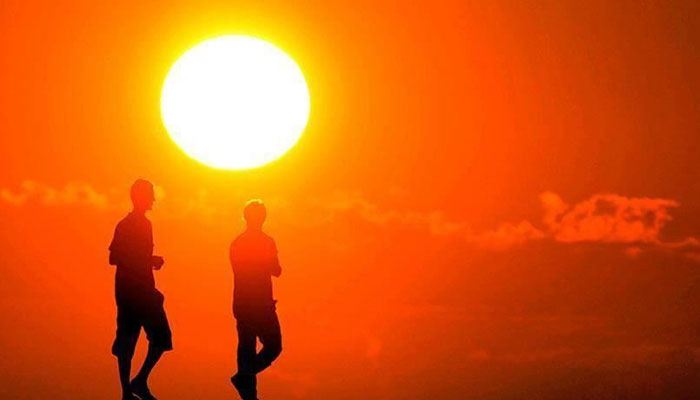Pakistan pummelled by heatwave that hits 50°C in some parts
Swathes of Pakistan have been smothered by high temperatures since April in extreme weather that the World Meteorological Organisation (WMO) has warned is consistent with climate change
JACOBABAD: Pakistan was in the grip of an extreme heatwave on Friday, with some parts reaching a temperature of 50 degrees Celsius as officials warned of acute water shortages and a health threat.
Swathes of Pakistan have been smothered by high temperatures since April in extreme weather that the World Meteorological Organisation (WMO) has warned is consistent with climate change.
On Friday, Jacobabad hit 50C (122 degrees Fahrenheit), the Pakistan Meteorological Department (PMD) said, with temperatures forecast to remain high until Sunday.
“It’s like fire burning all around,” said labourer Shafi Mohammad, who is from a village on the outskirts of Jacobabad, where residents struggle to find reliable access to drinking water.
Nationwide, the PMD alerted temperatures were between 6C and 9C above normal, with Islamabad as well as Karachi, Lahore and Peshawar recording temperatures around 40C on Friday.
“This year we have jumped from winter right into summer,” said PMD chief forecaster Zaheer Ahmad Babar. Pakistan has endured heightened heatwaves since 2015, he said, especially in upper Sindh and southern Punjab, adding: “The intensity is increasing, and the duration is increasing, and the frequency is increasing.”
Bashir Ahmed, a nurse from Jacobabad, said that, for the past six years, heatstroke cases in the city have been diagnosed earlier in the year -- starting in May, rather than June or July. “This is just increasing,” he said.
Punjab irrigation spokesman Adnan Hassan said the Indus River, Pakistan’s key waterway, had shrunk by 65 percent “due to a lack of rains and snow” this year. Sheep have reportedly died from heatstroke and dehydration in the Cholistan Desert of Punjab, which also serves as the national breadbasket.
“There is a real danger of a shortfall in food and crop supply this year in the country, if the water shortage persists,” Hassan said. Climate Minister Sherry Rehman this week warned the residents of Lahore “to take cover for the hottest hours of the day.”
The country has also faced severe power outages, with some rural areas getting as few as six hours of electricity a day. Home to 220 million, Pakistan says it is responsible for less than one percent of global greenhouse gas emissions. But it ranks as the nation eighth most affected by extreme weather events, according to a 2021 study by environmental group Germanwatch.
Extreme heat can also trigger cascading disasters that could pummel the country’s generally impoverished population. The mountainous portions of the country are home to more than 7,000 glaciers, a number larger than any region outside the poles.
Quickly melting glaciers can swell lakes, which then burst their banks and unleash torrents of ice, rock and water in events known as glacial lake outburst floods. Last weekend, a key highway bridge in Gilgit-Baltistan was swept away in flash flooding caused by glacier melt.
In April, the officials warned there were 33 lakes in danger of unleashing similar dangerous deluges. Meanwhile, the month of May 2022 is proving to be the third consecutive ‘warmest and driest month’ in the history of Pakistan as mercury touched 50 degrees Celsius in Jacobabad town of Sindh on Friday, while 49 degrees Celsius was recorded in Dadu and Larkana cities of the province, the Pakistan Meteorological Department (PMD) said.
“This month of May 2022 is also proving to be the warmest and driest consecutively after March and April 2022. The hottest day of this year was recorded in Jacobabad in Sindh, where mercury touched 50 degrees Celsius,” Chief Meteorological Officer (CMO) Sindh Dr Sardar Sarfraz told The News on Friday.
Weather experts are linking the extreme heat and dryness in Pakistan to the climate change, which is badly affecting Pakistan where extreme heat, continued dryness and lack of rains may result in food insecurity due to less crops and fruits.
Dr Sarfraz maintained that a high pressure area in the upper atmosphere of Pakistan was responsible for the extreme dry conditions and extraordinary heatwaves and added that they were not seeing any relief in the hot and dry conditions in the plains of the country at least for the next two weeks.
The PMD officials said they were expecting the prevailing heatwave conditions in the plains of Sindh and Punjab as well as Balochistan to continue at least for the next three more days, adding that they were not hoping any considerable rains anywhere in the country for next two weeks except for some areas in the northern areas.
“So, it appears that we are also having another warmest and driest month in the history of the country, the third one as extreme weather events started a couple of weeks earlier than expected in this month,” Sardar Sarfraz said, adding that they were expecting some showers in the first week of June 2022 by looking at the present weather conditions.
On the other hand, Karachi also sizzled at 41 degrees Celsius on Friday, he said, adding that the weather would remain hot and humid on Saturday and Sunday with temperature ranging between 38-40 degrees Celsius.
A weather advisory, issued by the PMD, said the severe heatwave conditions in most parts of Sindh would persist for next two days and they are likely to ease down a bit with 2 to 3 degrees temperature drop during 15-16 May.
The heatwave is likely to intensify again from May 17 onwards in central and upper Sindh with maximum temperature range of 46-48 degrees Celsius in Dadu, Nawabshah, Jacobabad, Larkana, Shikarpur, Qambar-Shahdadkot, Khairpur and Sukkur districts.
Similarly, Hyderabad, Mirpurkhas, Umerkot, Sanghar, Tharparkar and Badin are likely to experience 44-46 degrees Celsius during the next two days, the advisory said and advised the people to avoid open sun exposure as much as possible, especially during peak heat hours.
-
 South Korea Passes World’s First Comprehensive AI Law, Reshaping Global Regulation
South Korea Passes World’s First Comprehensive AI Law, Reshaping Global Regulation -
 ‘Disgraced’ Andrew’s New Demands Exposed As He Moves Out Of Royal Lodge
‘Disgraced’ Andrew’s New Demands Exposed As He Moves Out Of Royal Lodge -
 Court Allows TikTok To Operate In Canada Pending Review
Court Allows TikTok To Operate In Canada Pending Review -
 Kyle Richards Lashes Out At Ashley Darby For Flirting With Ex Mauricio Umansky
Kyle Richards Lashes Out At Ashley Darby For Flirting With Ex Mauricio Umansky -
 Chris Noth Breaks Silence On Fallout With Sarah Jessica Parker: 'We're Not Friends'
Chris Noth Breaks Silence On Fallout With Sarah Jessica Parker: 'We're Not Friends' -
 Prince Harry, Meghan Markle Show Awkward Mismatch In Viral Video
Prince Harry, Meghan Markle Show Awkward Mismatch In Viral Video -
 Madelyn Cline Surprises With Chic New Hairstyle
Madelyn Cline Surprises With Chic New Hairstyle -
 Amelia Gray Gushes About Megan Trainor, Ben Platt
Amelia Gray Gushes About Megan Trainor, Ben Platt -
 Prince Harry On Moment Meghan Markle Made Him Feel Like A ‘teenager’
Prince Harry On Moment Meghan Markle Made Him Feel Like A ‘teenager’ -
 Zayn Malik Debuts Four Unreleased Songs At Vegas Residency Premiere
Zayn Malik Debuts Four Unreleased Songs At Vegas Residency Premiere -
 Katy Perry 'wants' Justin Trudeau’s Baby
Katy Perry 'wants' Justin Trudeau’s Baby -
 Prince William, Kate Middleton’s Frustrations Rise As Divorce Rumors Finally Get Answered?
Prince William, Kate Middleton’s Frustrations Rise As Divorce Rumors Finally Get Answered? -
 Charlie Puth Gets Real About Super Bowl Anthem Role
Charlie Puth Gets Real About Super Bowl Anthem Role -
 Kim Kardashian Explains Why She Rarely Sees Jonathan Cheban Now
Kim Kardashian Explains Why She Rarely Sees Jonathan Cheban Now -
 Meghan Markle Spilt ‘third Date’ Magic With Prince Harry
Meghan Markle Spilt ‘third Date’ Magic With Prince Harry -
 When Will 'Jujutsu Kaisen' Season 3 Ep 4 Come Out?
When Will 'Jujutsu Kaisen' Season 3 Ep 4 Come Out?




